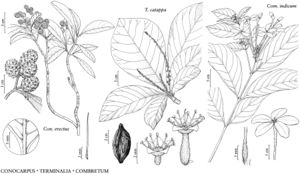Terminalia catappa
Syst. Nat. ed. 12, 2: 674. 1767.
Trees or shrubs to 20 (–35) m; branches without thorns. Leaves persistent or tardily deciduous (then turning red and plants briefly leafless); petioles 5–28 mm; blade obovate, 6–35 × 2.6–16.5 cm, base narrowly cuneate to rounded or narrowly and obscurely cordate, apex acuminate or short-acuminate to obtuse or rounded, surfaces glabrate to moderately pubescent abaxially, midvein and secondary-veins sparsely to densely pubescent, with nectar glands near base, glabrous or glabrate adaxially, midvein densely to sparsely pubescent, at least basally; with pit-domatia at junction of secondary and tertiary-veins with midvein, or junction of tertiary with secondary-veins, or other vein junctions. Spikes 5–25 cm, with bisexual flowers proximally, staminate flowers distally. Flowers 5-merous, bisexual and staminate; free portion of hypanthium 1–2 mm; sepals 1–2.8 mm; stamens 3–4.5 mm; style 3.5–4 mm. Drupes green or red, slightly flattened, ovoid to ellipsoid, 35–70 × 20–50 mm, sparsely pubescent or glabrous; with 2 well-developed ridges or wings; hypanthium and calyx deciduous in age.
Phenology: Flowering spring–summer.
Habitat: Disturbed habitats, especially near coast.
Elevation: 0–10 m.
Distribution
Introduced; Fla., Asia, Pacific Islands, n Australia, also widely in Neotropics
Discussion
Terminalia catappa is commonly used as an ornamental tree in southern Florida, and has naturalized in Brevard, Broward, and Miami-Dade counties.
Selected References
None.
